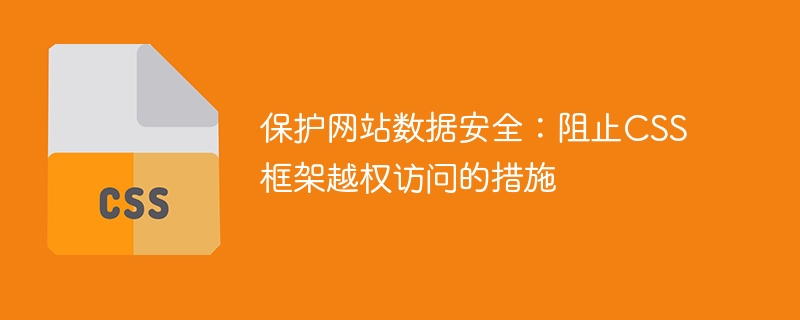Home >Web Front-end >CSS Tutorial >Prevent CSS framework from unauthorized access to protect website data security
Prevent CSS framework from unauthorized access to protect website data security
- WBOYWBOYWBOYWBOYWBOYWBOYWBOYWBOYWBOYWBOYWBOYWBOYWBOriginal
- 2024-01-16 10:41:06562browse

Protecting website data security: Measures to prevent unauthorized access to CSS frameworks
With the popularity and development of the Internet, more and more companies and individuals have their own website. The data security issues of websites are gradually becoming more and more important. As an integral part of the website development process, CSS framework plays an important role in website design. However, since CSS frameworks often need to access and manipulate website data, the risk of unauthorized access cannot be ignored. This article will introduce some measures to prevent unauthorized access of CSS frameworks to protect the security of website data.
First of all, it is very important to set strict access permissions for the website. By controlling access rights to CSS frameworks, you can prevent unauthorized access and manipulation of website data. Website administrators can manage the access permissions of the CSS framework through configuration files or user permission tables in the database, and only allow users or user groups with specific permissions to access and operate the CSS framework. At the same time, permission settings should be regularly reviewed and updated to ensure that only legitimate users can use the CSS framework.
Secondly, using the latest CSS framework version is also an important means to ensure website data security. Developers of CSS frameworks often fix vulnerabilities and security issues in the framework and release updated versions. Therefore, using the latest versions of CSS frameworks can reduce the risk of unauthorized access. Website administrators should pay attention to the official website and community of the CSS framework in a timely manner to understand the release of the latest version, and promptly update the CSS framework used in the website.
In addition, it is also very important to conduct security assessment and testing of CSS frameworks. Through security assessment and testing of CSS frameworks, potential security holes and issues can be discovered and fixed. Testing of the CSS framework can include different methods such as code review, black box testing and white box testing to ensure that there are no security issues in its design and implementation. At the same time, you can also use web application security scanning tools to actively scan the CSS framework to discover vulnerabilities and repair them in a timely manner.
Finally, establishing a good communication channel with CSS framework developers is also an important factor in ensuring website data security. CSS framework developers usually issue security bulletins and warnings regularly to remind website developers and administrators of potential security risks and issues. Website developers and administrators should keep in touch with CSS framework developers, keep abreast of the latest security developments, and take appropriate measures to protect the security of website data.
To sum up, preventing unauthorized access of CSS frames is one of the important measures to protect website data security. By setting strict access permissions, using the latest CSS framework version, conducting security assessments and tests, and establishing good communication channels with CSS framework developers, data security issues caused by unauthorized access by the CSS framework can be effectively prevented. Protecting website data security is not only the responsibility of website developers and administrators, but also requires the participation and attention of the majority of Internet users. Only through joint efforts can we build a more secure and reliable Internet environment.
The above is the detailed content of Prevent CSS framework from unauthorized access to protect website data security. For more information, please follow other related articles on the PHP Chinese website!
Related articles
See more- Is bootstrap a css framework?
- When enjoying the convenience brought by cloud services, who has the initiative in data security?
- Front-end Crypto.jsAES encryption, PHP openssl_decrypt() decryption for secure data transmission
- Artificial intelligence applications face seven major data security threats
- Let's discuss data security challenges and countermeasures in the era of artificial intelligence. 'Pujiang Escort” Data Security Shanghai Forum was held in Yangpu

